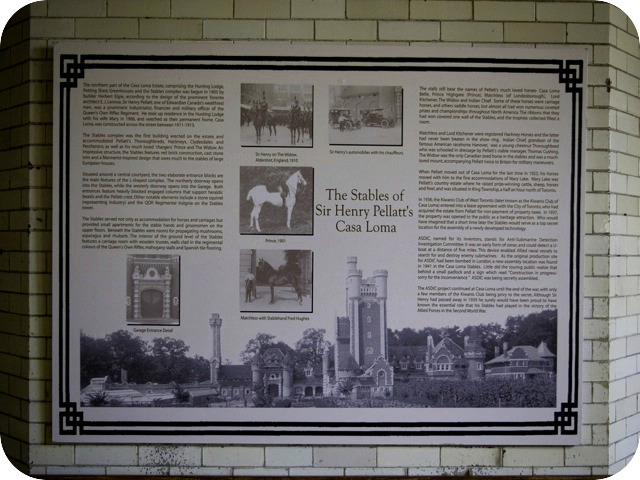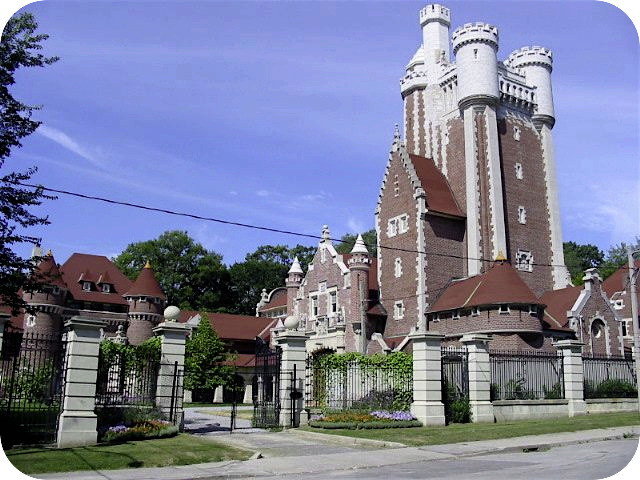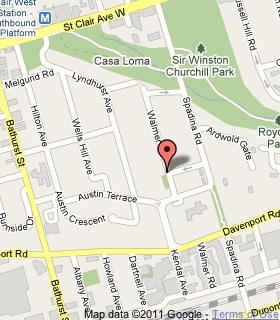Discover Toronto's history as told through its plaques
2004 - Now in our 14th Year - 2018
To see what's new on this site, you can visit the Home Page
Looking at this page on a smartphone?
For best viewing, hold your phone in Landscape mode (Horizontal)
The Stables of Sir Henry Mill Pellatt's Casa Loma

Photo by contributor Christopher Lancaster - March 22, 2008

Photo by Alan L Brown - Posted September, 2006
At 330 Walmer Road are the former stables for Casa Loma. This plaque, inside the building, is attached to the wall opposite the stalls, to the right of the door beside the tack rooms. Here's what it says:
Coordinates: 43.679225 -79.410703 |
 |
The northern part of the Casa Loma Estate, comprising the Hunting Lodge, Potting Shed, Greenhouses and the Stables complex was begun in 1905 by builder Herbert Elgie, according to the design of the prominent Toronto architect E.J. Lennox. Sir Henry Pellatt, one of Edwardian Canada's wealthiest men, was a prominent industrialist, financier and military officer of the Queen's Own Rifles Regiment. He took up residence in the Hunting Lodge with his wife Mary in 1906, and watched as their permanent home, Casa Loma, was constructed across the street between 1911-1913.
The Stables complex was the first building erected on the estate, and accommodated Pellatt's Thoroughbreds, Hackneys, Clydesdales and Percherons, as well as his much loved 'chargers' Prince and The Widow. An impressive structure, the Stables features red brick construction, cast stone trim and a Mannerist-inspired design that owes much to the stables of large European houses.
Situated around a central courtyard, the two elaborate entrance blocks are the main features of the L-shaped complex. The northerly doorway opens into the Stables, while the westerly doorway opens into the Garage. Both entrances feature heavily blocked engaged columns that support heraldic beasts and the Pellatt crest. Other notable elements include a stone squirrel (representing industry) and the QOR Regimental insignia on the Stables tower.
The Stables served not only as accommodation for horses and carriages but provided small apartments for the stable hands and groomsmen on the upper floors. Beneath the stables were rooms for propagating mushrooms, asparagus and rhubarb. The interior of the ground level of the Stables features a carriage room with wooden trusses, walls clad in the regimental colours of the Queen's Own Rifles, mahogany stalls and Spanish tile flooring.
The stalls still bear the names of Pellet's much loved horses- Casa Loma Belle, Prince Highgate (Prince), Matchless (of Londesborough), Lord Kitchener, The Widow and Indian Chief. Some of these horses were carriage horses, and others saddle horses, but almost all had won numerous coveted prizes and championships throughout North America. The ribbons that they had won covered one wall of the Stables, and the trophies collected filled a room.
Matchless and Lord Kitchener were registered Hackney Horses and the latter had never been beaten in the show ring. Indian Chief, grandson of the famous American racehorse Hanover, was a young chestnut Thoroughbred who was schooled in dressage by Pellatt's stable manager, Thomas Cushing. The Widow was the only Canadian bred horse in the stables and was a much-loved mount, accompanying Pellatt twice to Britain for military maneuvers.
When Pellett moved out of Casa Loma for the last time in 1923, his horses moved with him to the fine accommodations of Mary Lake. Mary Lake was Pellatt's country estate where he raised prize-winning cattle, sheep, horses and fowl, and was situated in King Township, a half an hour north of Toronto.
In 1936, The Kiwanis Club of West Toronto (later known as the Kiwanis Club of Casa Loma) entered into a lease agreement with the City of Toronto, who had acquired the estate from Pellatt for non-payment of property taxes. In 1937, the property was opened to the public as a heritage attraction. Who would have imagined that a short time later the Stables would serve as a top secret location for the assembly of a newly developed technology.
ASDIC, named for its inventors, stands for Anti-Submarine Detection Investigation Committee. It was an early form of sonar and could detect a U-boat at a distance of 8 km. This device enabled Allied naval vessels to search for and destroy enemy submarines. As the original production site for ASDIC had been bombed in London, a new assembly location was found in 1941 in the Casa Loma Stables. Little did the touring public realize that behind a small padlock and a sign which read "Construction in progress-sorry for the inconvenience" ASDIC was being secretly assembled.
The ASDIC project continued at Casa Loma until the end of the war, with only a few members of the Kiwanis Club being privy to the secret. Although Sir Henry had passed away in 1939 he surely would have been proud to have known the essential role that his Stables had played in the victory of the Allied Forces in the Second World War.
Related webpages
Casa Loma
E.J. Lennox
Sir Henry Pellatt
Queen's Own Rifles
Mary Pellatt
Thoroughbreds
Hackney Horses
Clydesdales
Mannerist-inspired design
mahogany
Hanover
Kiwanis
sonar
U-boat
Allied Forces
Related Toronto plaques
Casa Loma and the Pellatts
Sir Henry Mill Pellatt 1859-1939
Casa Loma
Casa Loma Stables
More Toronto buildings designed by E.J. Lennox
House of Industry
The King Edward Hotel
Massey-Harris Company
Mount Pleasant Cemetery
"Old" City Hall
Queen City Yacht Club
Standard Woollen Mills Building
Here are the visitors' comments for this page.
> Posted April 27, 2011
My great uncle was Herbert Elgie. He is mentioned on the plaque as the builder of the stables at Casa Loma. I'm wondering if in any research, anyone learned any details of his life, connection with the owners, etc. My understanding is that he was also the builder of many churches in Toronto. Thank you for any info you can pass along or anywhere I might find information on him.
Thanks! Fred Joblin [email protected]
Here's where you can send me a comment for this page.
Note: Your email address will be posted at the end of your comment so others can respond to you unless you request otherwise.
Note: Comments are moderated. Yours will appear on this page within 24 hours (usually much sooner).
Note: As soon as I have posted your comment, a reply to your email will be sent informing you.
To send me your comment, click [email protected].
Thanks
Webmaster
Note: If you wish to send me a personal email, click here.